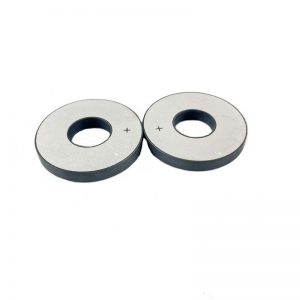 The principle of piezoelectric ceramic transducer is that when pressure or tension is applied to the ceramic plate, opposite polarity charges are generated at both ends of the ceramic plate, and current is generated through the circuit. This effect is called the piezoelectric effect. Therefore, in the design of ultrasonic transducers, various factors should be considered, such as acoustic impedance, frequency response, impedance matching, acoustic structure, vibration mode, and conversion material, as well as how to design and coordinate these factors to achieve the optimal value of electro-acoustic conversion. Piezoelectric ceramic transducers, as an energy transmission network, have energy conversion efficiency issues.
The principle of piezoelectric ceramic transducer is that when pressure or tension is applied to the ceramic plate, opposite polarity charges are generated at both ends of the ceramic plate, and current is generated through the circuit. This effect is called the piezoelectric effect. Therefore, in the design of ultrasonic transducers, various factors should be considered, such as acoustic impedance, frequency response, impedance matching, acoustic structure, vibration mode, and conversion material, as well as how to design and coordinate these factors to achieve the optimal value of electro-acoustic conversion. Piezoelectric ceramic transducers, as an energy transmission network, have energy conversion efficiency issues.
| spec | Dimension (Mm) |
Radial frequency (Khz) |
Capacitance (pf) |
Dielectric dissipation factor tanδ(%) |
Electromechanical coupling coefficient (Kr) |
Impedance Zr(Ω) |
Thickness frequency (Khz) |
| PU-PC25103 | Φ25×Φ10×3 | 66.4 | 1240±12.5% | ≤0.3 | ≥0.46 | ≤15 | 683±5% |
| PU-PC225104 | Φ25×Φ10×4 | 66.4 | 930±12.5% | ≤0.3 | ≥0.46 | ≤15 | 512±5% |
| PU-PC40155 | Φ40×Φ12×5 | 45.9 | 2070±12.5% | ≤0.3 | ≥0.46 | ≤15 | 410±5% |
| PU-PC40155 | Φ40×Φ15×5 | 42.2 | 1960±12.5% | ≤0.3 | ≥0.46 | ≤15 | 323±5% |
| PU-PC40176 | Φ40×Φ17×6 | 40.5 | 1555±12.5% | ≤0.3 | ≥0.46 | ≤15 | 341±5% |
| PU-PC40205 | Φ40×Φ20×5 | 37.9 | 1700±12.5% | ≤0.3 | ≥0.47 | ≤15 | 410±5% |
| PU-PC50206 | Φ50×Φ20×6 | 33.2 | 2490±12.5% | ≤0.3 | ≥0.46 | ≤15 | 341±5% |
| PU-PC501765 | Φ50×Φ17×6.5 | 34.8 | 2430±12.5% | ≤0.3 | ≥0.46 | ≤15 | 315±5% |
| PU-PC50236 | Φ50×Φ23×6 | 31.2 | 2340±12.5% | ≤0.3 | ≥0.47 | ≤15 | 341±5% |
| PU-PC50276 | Φ50×Φ27×6 | 29.3 | 2100±12.5% | ≤0.3 | ≥0.47 | ≤15 | 341±5% |
| PU-PC603010 | Φ60×Φ30×10 | 25.3 | 1922±12.5% | ≤0.3 | ≥0.47 | ≤18 | 205±5% |
 Ultraschall-Wandler,Ultraschall-Generator,Ultraschall-Reiniger -SKSONIC
Ultraschall-Wandler,Ultraschall-Generator,Ultraschall-Reiniger -SKSONIC







